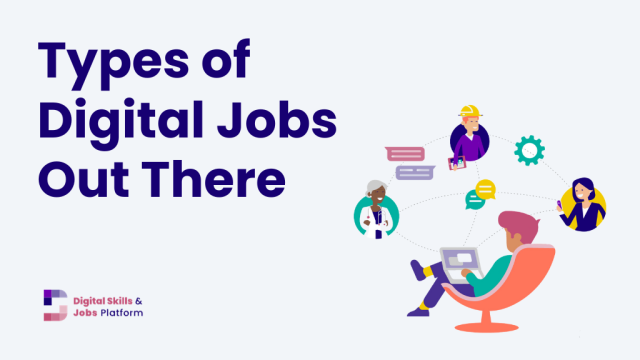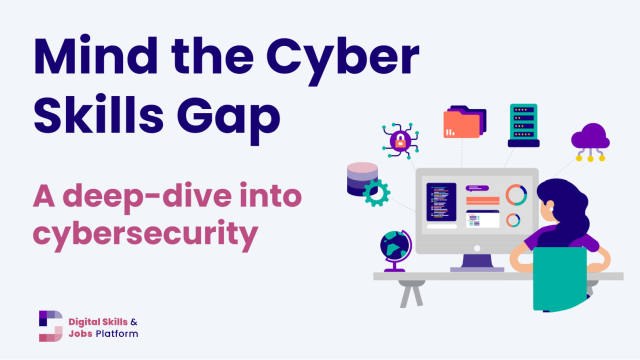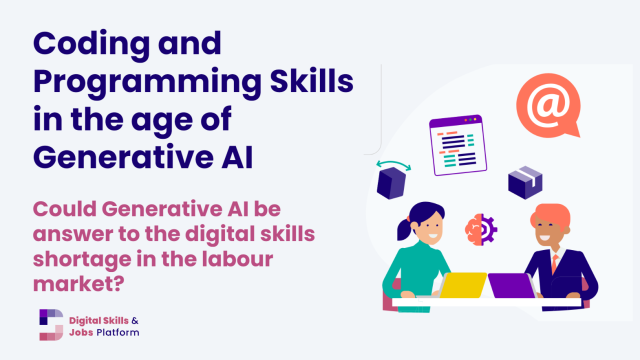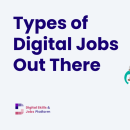Digital Skills: a deep-dive

The digital world already pervades many aspects of our daily lives. We use search engines to find out the result of a football match, manage our money transfers through online banking apps, pay our taxes using governments’ web portals, book flights or accommodation in travel web portals, use messaging software to chat with friends and share photos and videos. And we would not be able to do any of those things without digital skills. Basic digital skills, at their very essence, are a crucial step towards learning many other new things – and aiming higher, for new knowledge. They give confidence to use technology for work, learning and daily life.
About the author
Luis has a BSc and MSc in Informatics from the Universidad Politécnica de Madrid (UPM) since 1989. He earned his PhD with extraordinary award from the University of Basque Country in 1997. He has served as interim associate professor at UPM (1989-1996), aggregate professor and head of department at Universidad Europea de Madrid (1996-2008) and associate professor at Universidad de Alcalá (since 2008). He was the CEO of an ICT service-oriented SME (2002-2006) and has acted as freelancer consultant for big companies. Luis has been a board member of CEPIS (2011-13, 2016-2020), and as of 2022 he is CEPIS’s president. Over the years, he has helped to shape the development of EU reference frameworks for digital skills and employment. Luis has actively contributed as an official expert to the development of the three main references in the area: the ESCO labour classification for ICT services, the European standard of e-competences for ICT professionals EN6234-1:2019 and DigComp, the Digital Competence Framework for Citizens.
Introduction
If we take a look at labour market trends, we can see that the digital transition has brought up specific needs and transformed many occupations and tasks. Most jobs today require some level of digital skills, including even those that do not ask for high levels of qualifications or experience - like working in a warehouse or as shop assistant, checking stock and inventory. Increasingly, the work of other specialists with higher qualifications in their respective disciplines, is now also dependent on digital skills: biologists need to work with complex digital 3D representations of molecule structures, lawyers now consult big juridical databases to study precedents and all aspects of legislation.
Digital skills are now needed in most jobs: and specific digital skills are also permeating traditional professions to varying degrees. Think of doctors, who work with the latest robotics technology to perform complex surgeries (more specialised skills), manufacturing employees that use industrial robots to speed up processes (different levels depending on the employee’s function), or teachers introducing digital and emerging technologies into teaching and learning. In Europe, just 54% of people have the digital skills needed for the digital world we live in (European Commission, DESI 2022). In 2021, 1 in 6 Europeans aged 16-74 had no digital skills at all and 1 in 4 of that group only had a low level of digital skills. This naturally brings challenges to the labour market, due to the need for some digital competence across roles and occupations. Yet, DESI 2022 shows that around 35% of European citizens still lack even these basic digital skills – which means they are essentially excluded from the job market, and the opportunities made possible by digital technologies. This is combined with difficulties in finding and attracting digital talent, making it even harder to respond to industry needs. More than half of companies in Europe report big difficulties in recruiting ICT specialists (Joint Research Centre, European Commission, 2019), and SMEs in particular, lag behind their larger counterparts in training and upskilling due to limited resources (financial, staffing, etc). Similar data has been disseminated by the Digital Skills and Jobs Coalition, a partnership of organisations from the public, private and non-profit sectors that works to tackle digital skills shortages across Europe.
And if we are to take a closer look at the state-of-play with the labour market in Europe, data and information available point to the need for an urgent push to develop the digital skills of EU citizens and make them fit for employment. Data from CEDEFOP (the EU’s Agency for the Development of European Vocational Education and Training) shows the importance of digital skills for jobs. In 2015, 71% of EU employees thought some fundamental level of digital skills was needed to perform their jobs. More recent data on skills that employers demand, based on millions of Online Job Advertisements (OJAs) in 28 European countries, extracted from the OVATE tool of CEDEFOP shows that digital skills are explicitly mentioned by employers (e.g., “Working with computers” was a requirement in close to 40% of all OJAs across sectors). Many other OJAs simply assume that candidates have such skills.
Digital skills are relevant and needed, and EU policymaking has tried to reflect this. In 2018, the Council of the European Union adopted a recommendation on 8 key competences to support Europeans in gaining the skills and competences needed for personal fulfilment and wellbeing, employability, and social inclusion. This also highlights efforts put in re- and up-skilling policies around digital skills: in 2018, more than half of Europeans lacked digital skills. In 2021, 54% of people aged 16 to 74 had at least a basic level of digital skills (DESI 2022).
Basic definitions for digital skills
Before defining digital skills it is relevant to firstly clarify some more general terms. These terms are: "competence", "skills", "knowledge", and "attitude". (European Commission, 2019) and they have applied to the main EU reference on digital competence, DigComp (now in its 2.2 edition), which we will talk about further on.
- Competence is the demonstrated ability to apply knowledge, skills, and attitudes for achieving observable results. For example, competence “Programming” can be described as “To plan and develop a sequence of understandable instructions for a computing system to solve a given problem or to perform a specific task”.
- A skill is the ability to carry out processes and use the existing knowledge to achieve results: e.g., “Able to verify and modify what type of metadata (e.g., location, time) is included in pictures being shared in order to protect privacy”.
- Knowledge is composed of the concepts, facts and figures, ideas and theories which are already established, and support the understanding of a certain area or subject: e.g., “Knows the main functions of the most common digital devices (e.g., computer, tablet, smartphone)”.
- Attitudes describe the disposition and mindset to act or react to ideas, persons, or situations: e.g., “Open towards sharing digital content that might be interesting and useful to others”.
See our infographic below for an illustration of this.


Getting to a definition of digital skills
The UNESCO Institute for Statistics (2009) defines digital skills as “a range of abilities to use digital devices, communication applications, and networks to access and manage information”. These abilities make possible creating and sharing digital content, communicating, and collaborating with others, solving problems, and finding creative opportunities. Similarly, the Council Recommendation on Key Competences for Life-long Learning defined digital competence as ‘the confident, critical and responsible use of, and engagement with, digital technologies for learning, at work, and for participation in society. It is defined as a combination of knowledge, skills, and attitudes’.
There is a strong link between digital skills and key competences enabling lifelong learning. European citizens should be equipped with key skills, needed for an increasingly digital world: such as the ability to filter, use, access or manage private data, personal information, one’s digital footprint, stay safe online and effectively use technologies like AI and other software. People should also ‘be able to use digital technologies to support their active citizenship and social inclusion, collaboration with others, and creativity towards personal, social, or commercial goals’ (European Commission, 2019).
This concept of digital skills is more concerned with European citizens in general, rather than the specialised skills for ICT professionals. The EU framework for citizens’ digital competence (DigComp), which we will look more in detail later, contains an outline of the digital skills citizens need to remain competitive on the labour market, socialise, shop, and learn in today’s digital world.
Categories and levels of digital skills
There are two main categories of digital skills out there:
- the general ones applicable to common context of life and work, and
- the professional ones for ICT experts.
In the case of the Category A (people in general) common EU frameworks like DigComp covers a range of levels of digital skills from basic to very specialised, so the spectrum of general digital skills could be wide and varied. They range from really foundational level such (e.g., mere use of a PC, tablet or mobile device for emailing or internet browsing) to some moderate ICT use (like productivity and office tools like word-processing, creating documents and/or spreadsheets) and some advanced ICT skills (such as the initial ability to develop applications or programming or using sophisticated computer statistical analysis packages). DigComp defines 4 layers of proficiency such as foundation, intermediate, advanced, and highly-specialised.
Above those levels of general digital skills, we can find specific skills for those in ICT profession such as using software design patterns or defining firewall rules. There is a tenuous and fuzzy limit, really difficult to strictly define, between the upper levels of digital skills of those not specifically qualified as ICT professionals and the basic levels of skills of those in the professional field of technology. A good number of the skills in that limit between general digital competence and ICT professionalism frequently lie in the context of hybrid digital jobs such as digital compliance assessor. The standard EN16234-1:2019 (CEN, 2019), known as the e-Competence Framework, defines 41 e-competences, tens of examples of highly specialised skills for them and up to five levels of proficiency, which are mostly above the eight levels defined by DigComp for general citizens. Level 1, the lowest of EN16234 refers to the most basic professional skills where practitioners mostly follow well-defined procedures in structured situations: like in the case of performing simple tests of applications or acting in strict compliance with detailed instructions.
The categories and levels of digital skills and competences could also be complemented with streamlined and effective policy action. For example, the EU Digital Skills and Jobs Coalition mentions the following ones:
- Digital skills for all, to enable all citizens to be active in our digital society.
- Digital skills for the labour force for the digital economy.
- Digital skills for ICT professionals and other digital experts, across industry sectors
- Digital skills in education, for teaching and learning of digital skills in a lifelong learning perspective, including the training of teachers.
The importance of terminology and frameworks
As it's been the case with digital jobs, the interest in digital skills has enabled a prolific period of initiatives and proposals of models and training options. The rapid development and the high numbers of options have sometimes hindered the best understanding by the general public, policy makers, employers, professionals related to education and training, etc. This situation bears a strong similarity to the landscape for training and certification in foreign languages in Europe before the Common European Framework of Reference for Languages (CEFRL) was first published back in 2001. Before the framework’s birth, the definition of competence in a foreign language was subject to an unclear selection of existing certificates from different systems, making it challenging to compare the achievement of people in languages.
Fortunately, the EU has developed Digital Competence Framework for Citizen (DigComp) to act in similar way as CEFRL did in the past for languages. DigComp provides a common understanding of what digital competence is: version 2.2 (Vuorikari et al., 2022) has been published in March 2022. As stated in the framework, the model covers different levels of digital competence for citizens with five competence areas (Information and data literacy, Communication and collaboration, Digital content creation, Safety, and Problem-solving); and 21 specific competences, each of which described in 8 proficiency levels (see Figure 1. Structure of competences areas and competences in DigComp below). Levels range from “Foundation” as label for levels 1 and 2 up to “Highly specialised” for levels 7 and 8.
The highest level is similar to the one required for professionals in hybrid jobs or, in some cases, to ICT-intensive jobs. The last version 2.2 of DigComp can enhance a more homogeneity in interpretation of competences thanks to the extensive set of 250 examples. The following ones are examples of knowledge, skills, and attitudes for some of the competences described in DigComp:
- Area 1. Information and data literacy
- Competence 1.2 Evaluating and digital content, knowledge
- Example 19: “Aware of potential information biases caused by various factors (e.g., data, algorithms, editorial choices, censorship, one’s own personal limitations)”
- Area 2. Communication and collaboration
- Competence 2.3 Collaborating through digital technologies
- Example 85: “Knows how to use digital tools to facilitate and improve collaborative processes, for example through shared visual boards and digital canvases (e.g. Mural, Miro, Padlet)"
- Area 4. Safety competence
- 4.2 Protecting personal data and privacy, attitudes
- Example 188: “Confident in carrying out online transactions after taking appropriate safety and security measures”.

As DigComp is addressed to digital competence of general citizens, there are other complementary models focused on other contexts (e.g., education) which can contribute to the best implementation and development of digital skills in EU. For example, DigCompEdu (Redecker and Punie, 2017) details 22 competences organised in six Areas, not focused on technical skills but on how digital technologies can be used to enhance and innovate education and training. There is also a version named as DigCompOrg (Kampylis et al., 2015) with seven key elements and 15 sub-elements intended as a comprehensive and generic conceptual framework that reflects all aspects of the process of systematically integrating digital learning in educational organisations. This framework is complemented by SELFIE (Self-reflection on Effective Learning by Fostering the use of Innovative Educational technologies).
Although still pending a clear solid framework of digital competence for the labour market, we can find some preliminary cases of using DigComp for jobs in (Kluzer et al., 2020). Another example is the project EU4D that also created a digital competence framework for SMEs combining DigComp and EN16234-1:2019 Standard (CEN, 2019) for the eSkills promotion for the states of the Eastern European Partnership.
DigComp has had a influence and impact on other relevant European frameworks and reference model for employment and education, for example: the e-CF EN16234-1:2019 Standard (CEN, 2019) has included an annex to explain the possible similarities and differences with it. Moreover, many local initiatives and models on digital skills have used DigComp as initial basis for their development and activity: (Kluzer and Pujol Priego, 2018) shows a good catalogue of them.
Assessing digital skills
Given the relevance of digital skills for many aspects of life and work, it is not only important to promote their development in all contexts (e.g., education, labour market, long life learning, etc.). Training and skilling cannot help if we do not have methods for assessing digital competence and, in the end, for knowing the real capacity of a person to apply digital skills in practice. Digital skills frameworks and models exist, but they are far from widespread and clear in practice – and the development of assessment methods to test skills has not been as relevant as it should have been. We need to make a distinction between skills assessment or self-evaluation mechanisms for individuals, and the use of general indicators to represent the acquisition of digital skills for large populations and countries.
Skills assessment for individuals
We can already find a good number of proposals of methods and schemes of assessment methods for digital skills at different levels. The panorama might be confusing and hard to compare and understand, as many of the options have not clearly defined their foundations and provided details to rely on their capacity to assess real digital competence of a person.
Logically, DigComp serves as basis for different tools and methods for assessment. They frequently appear as self-assessment tools like DigCompSAT (Clifford et al., 2020). Its approach is “not intended to measure the users’ current digital competence in view of its certification or similar purposes”. For example, the tool asks the users to declare in a scale their perceived capacity of skill to carry out some actions, e.g., “I know how to send, reply and forward e-mails”, the degree of knowledge in some aspects, e.g., “I know about digital tools that can help older people or people with special needs” or even the degree of adherence to some attitudes, e.g., “When I face a technical problem, I try step-by-step to identify the problem”.
Another tool is Test your digital skills!, developed based on an initiative by the European Commission, and hosted on the Digital Skills and Jobs Platform. Again, it works as self-assessment tool for one’s digital competence, but also offers a range of additional features:
- The tool requests on some data on the user’s part related to their education and occupation to provide some extra guidance at the end of test, not only highlighting the achieved level in each of the DigComp areas, but also suggesting learning paths to build further knowledge and improve competences.
- Similar to other tools, it contains questions based on the knowledge, skills, actions or habits as perceived by the user, such as “I know how to copy and move files” answering in a scale of capacity or autonomy for each case.
- But also includes typical test multiple choice questions with limited time to answer, checking knowledge on typical digital concepts: e.g., “What is the purpose of the Eraser tool?” or “How many digits are in a PUK code?”.
There are many self-assessment tools aligned to DigComp developed by local or national initiatives and frequently as result of EU-funded projects under programmes like Erasmus+. Of course, there are other tools inspired in other models or simply with no clear link to existing models or frameworks of general digital skills.
In the case of ICT professional skills, the development of general self-assessment tools is more difficult and less effective as the huge variety and sophistication of topics recommend focusing in a specific area in each case. However, the existence of the e-Competence Framework (standard EN16234-1) enables the work with general high level of e-competences applicable to all area of ICT profession. One relevant implementation of this idea is the self-assessment tool e-CF Explorer where ICT specialists can generate a profile of their e-competences through a self-assessment questionnaire and compare the result to one of the predefined recommended profile for common ICT professional roles.
General indicators of digital skills for large populations
On a general and higher policy level, the EU has the DESI (Digital Economy and Society Index), which summarises indicators on Europe’s digital performance and tracks the progress of EU Member States in particular areas, one of which is reserved for digital skills. Since its start in 2014, DESI covers four main areas of digital progress (Human Capital, Connectivity, Integration of digital technology and Digital public services). The first area collects the information related to digital skills firstly considering internet user skills (1a) detecting individual with, at least, basic digital skills, the ones with above basic digital skills and those with, at least, basic software skills. In this first area, there are also indicators on advanced skills and development (1b) counting numbers of ICT specialists, how many of them are female professionals, the number of enterprises providing ICT training and the number of ICT graduates.
The basis of methodology for part 1a is a survey to citizens (European Union survey on ICT usage in Households and by Individuals) asking about the number of activities carried out during the previous 3 months in four dimensions: information, communication, problem solving and software for content creation. As example of questions, surveyed citizens declare how frequently they use the internet (daily, once a week, once in last three months) or if they have ordered goods or services over the internet for private use in the previous 12 months. Part 1B is based on surveys and reports from labour market and education. DESI annual reports are used by policy makers and stakeholders in education and other areas to monitor the evolution of qualification of population in digital skills and competences (see Figure 2 - Report on evolution of digital skills in DESI Report 2018-2022 below).
The last DESI (European Commission, 2022) report shows that high percentages of individuals below 54 years old with at least with basic skills (ranging 55% to 71% depending on age) while older ones (above 65 yrs., 25%), retired and inactive (29%) and those with no or low formal education (32%) have the lowest percentages. Average for EU is 53.9%. Moreover, 26% of individuals have above basic digital skills.

Certification of digital skills
Although these tools are relevant and popular and contribute to the awareness of the concept of digital skills and the different competences covered by DigComp, it is necessary to have a mechanism to effectively assess the digital skills of people. Different studies have shown that the perception of digital skills by an individual, and the reality in practice did not match, with routinary overestimation of abilities. Even the Certification as basis for independent and objectively credentialing digital skills in a valid way for third parties is an essential element for the development of digital skills in all contexts.
In the case of Europe, the certification of general digital skills still appears muddled when compared with the case of language supported by CEFRL, commented above. There is a variety of digital skills training and certification opportunities offered by various organisations and governments, although few with relevant numbers of activity, i.e., millions of certificates (e.g., ICDL, Microsoft MOS, etc.). These certifications work in different way than the self-assessment tools mentioned earlier in this paper: they check the identity of candidates and ensure that they do the tasks and questions of tests independently and without extra help from either somebody, or their notes. Instead of questions on habits or knowledge, the tests also requests users’ answers on systematic questions on knowledge (usually framed as multiple-choice questions) in terms of some tasks taking place directly in the real computer environment where the system checks if the result is correct: e.g., “underline the word “xxx” in the given text”, “recover a deleted file from the recycle bin”, "set a password for a file", etc.
However, it is difficult to establish an easily recognisable qualification or certificate, massively adopted de facto in the job market or in education. This is the reason why the Digital Education Action Plan 2021-2027 included as Action 9 to “Develop a European Digital Skills Certificate (EDSC) that may be recognised and accepted by governments, employers and other stakeholders across Europe”. In February 2022, the European Commission launched a tender for a feasibility study exploring scenarios for the European Digital Skills Certificate (EDSC) with relevant conclusions expected towards the end of 2023 that will serve to better define a viable solution for this EDSC, probably ranging from mapping existing certifications to DigComp up to even develop a new option.
If we refer to certification of advanced digital skills and the ones for ICT professionals, the scenario looks a bit differently. There is a huge number of certifications already in the market: some unofficial non-exhaustive catalogues have identified more than 1,300 from more than 160 different providers. There are two main types of ICT professional certifications: the ones from technology vendors (e.g., Microsoft, CISCO, Oracle, etc.) that serve as main qualifications of capability of use of their tools and technology and the ones from independent entities (e.g., ISACA for IT security certifications, AXELOS on ITIL service management, etc.), focused on international methodologies, models, best practices or standards. There are many levels of exigence for earning certifications, from beginners’ level, containing simple tests to more advanced, experts’ certifications with tests, practical exercises, and review of CV – or in some cases, even with interviews. Some of them also require a regular maintenance. As shown in studies (García-García and Fernández-Sanz, 2007), ICT certifications represent a possible interesting option for entering the ICT professional world for those without a strong training or educational background in ICT; they also serve to enhance the specialisation of ICT graduates.
Looking to the future of digital skills and the EU Digital Decade
Digital skills have become essential for everybody in daily life, at work and in education. Although digital technology is not available to a large percentage of population, digital skills have not progressed at the same pace of access to devices, networks or application. Given the importance of digital transformation for Society and economy, the European Commission launched in 2021 the initiative of the Digital Decade to “empower businesses and people in a human-centred, sustainable and more prosperous digital future” with relevant targets with the horizon of 2030. There are two targets on skills: minimum of 80% of population with basic digital skills and 20 million of ICT specialists. We have seen along this document how both aspects are already supported by the existence of common frameworks that define details and guide the actions: DigComp and e-Competence Framework (standard EN16234). Both references are regularly updated to follow the fast evolution of technology and digital world.
If the need of digital skills is present in most of the personal and professional activities at present time, studies are forecasting a continuous growth in demand of digital skills for employment and professional career, putting digital literacy at the core of transversal skills (OECD, 2021). Even more aspects of specialised domains in ICT are pouring slowly but continuously into the pot of digital skills for citizens as the last version 2.2 of DigComp has showed with the inclusion of references to Artificial Intelligence. As we have commented before, although progressing and making efforts to expand digitisation and qualification in digital skills, the indicators in Europe are still far from what the EU requires for a prosper digital future. So, digital reskilling and upskilling with clear strategies of life-long learning will be the prominent trend from now.
Image credit: Kids, Adults and Computers at Hack4Kids" by Alexandre Dulaunoy is licensed under CC BY-SA 2.0.






